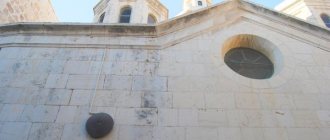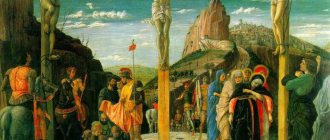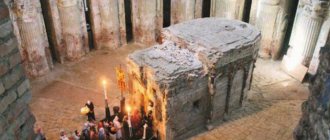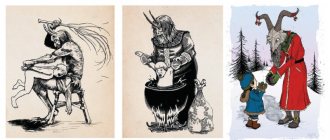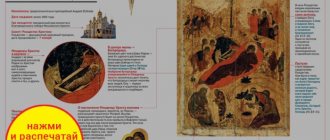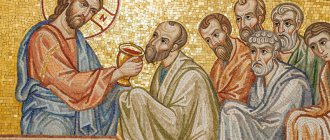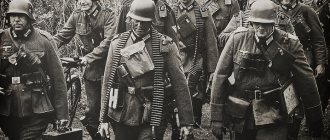There are still quarrels among Christians about where the place of execution of Jesus Christ is located.
So Orthodox and Catholics consider the true modern location of Golgotha at the end of the road of sorrow or Via Dolores. The Savior walked this path to death.
Protestants believe that Mount Golgotha is located north of Jerusalem, beyond its current borders. This place is usually called the Garden Grave.
In any case, the significance of the Place of Execution for Christianity is so great that at present, an entire temple complex called the “Church of the Holy Sepulcher” has been built on the site of the execution of Christ.
Golgotha is the place of executions, the Place of Execution
What Golgotha is is said in the New Testament. According to him, this is the Execution Place, that is, the place where public executions of criminals sentenced to death were carried out. In addition, Golgotha also refers to the place of crucifixion.
Jesus Christ was crucified here and here he accepted his martyrdom to atone for the sins of mankind so that people could enter the kingdom of heaven. In our time, Golgotha is located on the territory of the state of Israel, and it is recognized as one of the two main shrines of Christianity.
View of Calvary and the Stone of Confirmation. As a result of many reconstructions, Golgotha is now located inside the Church of the Holy Sepulcher. The hill itself was razed, and the rock of Golgotha was placed inside the Temple premises.
Translated from Greek, Hebrew and Aramaic, the word “Golgotha” is translated as skull. Initially, Golgotha, the site of the Lord’s crucifixion, was considered part of Gareb Hill.
From a geological point of view, it is a small rock or hill. Perhaps the mountain was so named due to its external resemblance to a human skull.
Calvary
translated from Irit and Aramaic - “skull”
Other names for this area have become firmly established in Christianity - the Latin “Calvaria” and the Greek “Great Kranion”, which in both cases means “skull”. According to another version, the name of the mountain comes from “Gol-Gofa”, which means “Mountain of Punishment”
General information
Mount Golgotha in Israel, on which, according to legend, Jesus Christ was crucified, is considered one of the two main shrines for Christians (the second is the Holy Sepulcher). Initially, it was part of the Gareb hill, but after its deliberate destruction for the construction of a church, the mountain became part of a single temple complex.
It reaches a height of 11.45 meters, the height above the floor is 5 meters. Located in the western part of the country, near the border between Israel and Jordan. Golgotha occupies a place of honor on the tourist map of Jerusalem - more than 3 million pilgrims come here every year, who are not stopped by either the scorching sun in July and August or huge queues.
Christian tradition places Golgotha outside the city walls of Jerusalem
In evangelical times, Christian tradition placed Golgotha outside the city walls to the northwest of the city in the early 1st century AD.
Currently, it is part of the Temple of the Lord in the Christian quarter of the city of Jerusalem.
Since the end of the 19th century, some researchers have put forward other versions of its location, for example, talking about the Garden Tomb, located in the north of Jerusalem at the Damascus Gate.
Garden tomb. The notches in the rock resemble a skull. Christian tradition places Golgotha outside the walls of Jerusalem. That is why the area of the Garden Tomb is considered an alternative location of Golgotha
In New Testament times, Golgotha occupied a large area of Israel, while beautiful gardens grew in the west of the mountain. They were planted on the site of a former quarry.
Mount Gareb was also adjacent to a small observation deck called the lookout. Here in ancient times people gathered to watch the execution of criminals.
In the 19th century, the graves of Joseph of Arimathea and Nicodemus were discovered next to the tomb of Christ.
A man-made cave was discovered on one of the slopes of the mountain. Prisoners sentenced to execution were temporarily kept here. Jesus Christ was also kept here before the crucifixion.
Subsequently, this cave received the name “Christ’s Prison”. There is a legend that the first man Adam is buried at the base of Golgotha.
Video: The Prison of Christ. Jerusalem. At 27 seconds the author shows the place where Jesus Christ awaited his execution in prison.
Under the mountain itself there was a deep pit where, after execution, the bodies of dead criminals, as well as the crosses on which they were crucified, were traditionally thrown. After the execution, the Cross of Christ was also thrown here, which was then covered.
It is known that since ancient times, people were buried on the slopes of Mount Golgotha, and one of these burials, which is located at the foot of the mountain on the western slope, is still revered to this day as the Tomb of Christ.
Archaeologists have figured out exactly how Jesus Christ was crucified
Jesus was not crucified as depicted in all paintings
Nails in the heels
Numerous artists who have depicted the crucified Jesus Christ for centuries have been wrong. Already the second archaeological discovery testifies: the nails with which the executioners nailed the body of the Savior to the cross are located on the paintings in the wrong places where they should be. The feet of the crucified were not pierced in the area of the metatarsal or tarsal bones, as is depicted in almost everyone. In fact, the legs were secured with one nail that passed through both heels - or rather, both heel bones. Characteristic damage in these places is present on the discovered remains - on the bones of people who died on crosses at the beginning of the first century AD. It was at this time that Jesus Christ was executed.
The first material confirmation that crucifixion as a cruel and painful execution really existed was received only in 1968. Then, in one of the burials in Jerusalem, archaeologists found two heel bones, fastened with an iron nail, on which a piece of wood was preserved. The nail was approximately 18 cm long, the piece of wood was 2 cm long. In 1985, the discovery was described in detail by the late Greek archaeologist Vassilios Tzaferis in the journal Biblical Archaeology Review in an article entitled Crucifixion—The Archaeological Evidence.
Nail-pierced heels found in Jerusalem.
According to Tzaferis, the bones belonged to a noble Jew, about 25 years old, who was crucified for some political crime. That is, for treason against Rome.
And recently, in the journal Archaeological and Anthropological Sciences, a description of a second similar find appeared - essentially the second material confirmation of the reality of the crucifixion. Italian scientists from the Universities of Florence and Ferrara reported on the results of a study of a skeleton discovered in northern Italy 60 kilometers from Venice during excavations in 2006-2007, which took place at the site of ancient burials.
Skeleton of a crucified man found near Venice.
The skeleton belonged to a man a little over 30 years old, who died and was buried about 2 thousand years ago. One of his heels is broken - the right one. Punched through - about the same as that of a victim of political repression from Jerusalem. There was, however, no nail. But archaeologists, having examined the holes - the entrance with a diameter of 9 millimeters and the exit with a diameter of 6.5 millimeters, nevertheless risked suggesting that the “Italian” was crucified. For some reason, he was “fixed” by only one heel. The nature of the damage to the bone indicated that it had been nailed to some hard surface.
In Jerusalem the nail had a rectangular cross-section, near Venice it had an oval cross-section. Archaeologists claim that it was precisely this type of fastener that was common in those places about 2 thousand years ago.
Holes in the heel of the Roman.
Model of a heel pierced with a nail. Heel from a Roman skeleton.
The place where the skeleton of a crucified Roman was found.
Nails in wrists
Italian archaeologists claim that “their” crucified man had characteristic injuries on his hands. They testify that the hands were nailed with nails piercing the wrists. What's in the paintings? Painters - again en masse - depict the crucified Jesus Christ with pierced palms. That is, they are wrong here too.
One example: Rubens depicted nails in the wrong place.
The fact that a person nailed to a cross by the palms of his hands will not last long on the cross was proven back in 1931 by the French surgeon Pierre Barbey. He experimented with the blessing of the Vatican and found out that under the weight of the body, the palms would very soon tear. But the wrists are much stronger in this sense.
It took several decades for the “medical discovery” to find at least one archaeological evidence - the same skeleton with holes in the heel and wrists, examined by the Italians - the descendants of the ancient Romans.
By the way, Vasilios Tzaferis, who described the “first crucified”, absolved them - the ancient Romans - of the accusation that they were the ones who invented execution by crucifixion. He assured that even in the first millennium BC, the Assyrians, Phoenicians and Persians committed atrocities in a similar way.
The “correct” position of the legs of an executed person according to archaeologists.
Traces on the Shroud of Turin
The Shroud of Turin is a linen cloth 437 centimeters long and 111 centimeters wide, which is kept in the Cathedral of John the Baptist in the Italian city of Turin. On the canvas there are two negative typos of the human body with signs of mutilation - in front and behind.
Some believe that it was in this cloth that the Savior, taken from the cross, was wrapped and placed in the coffin, whose body was imprinted on the cloth in a supernatural way. It “appeared” as if on photographic film during the process of resurrection.
Skeptics suspect that the shroud is fake after all. That is, the image on it, if not drawn, was somehow obtained artificially.
Skeptics point to a 1988 study in which three independent laboratories radiocarbon dated the fabric. And they came to the conclusion that the shroud was made in the period from 1260 to 1390. That is, it cannot be real. After all, Jesus Christ was crucified in 33 AD.
On the shroud there are images of numerous wounds received by the Savior before his death. The figure has pierced wrists. Which is archaeologically true, as has now become clear thanks to Italian scientists. This “detail” is in favor of the authenticity of the shroud. But the wounds on the legs are “wrong” - not in the heels. Which gives skeptics another reason to doubt the authenticity of the relic.
Emanuela Gualdi from the University of Ferrara, who examined the skeleton of a crucified man that was found near Venice, believes that the heels of the executed person were nailed to the vertical post of the cross in two ways. The first - both feet are turned in one direction, the second - the feet are turned in different directions. In any case, there was only one nail: the heels were combined and pierced at once. He allowed the victim to lean on him and thereby prolong her torment.
About the research of traces of blood found on linen, which may have become a burial cloth for Jesus Christ, read: The most convincing evidence of the authenticity of the Shroud of Turin has been obtained
A LITTLE EARLIER
Have the nails that nailed Jesus Christ to the cross been found?!
The Italians explained why there are holes from nails in the skeleton of “their” crucified man, but there are no nails themselves. Researchers claim that the nails from the crucifixion were not placed in graves, but were preserved. They were believed to have magical powers.
This scientific revelation lends more credence to a claim made by archaeologist, journalist and documentary filmmaker Simcha Jacobovici in his 2011 documentary The Nails of Christ.
Yakubovichi claims: two nails with rounded heads about 8 centimeters long, curved at the ends, which were discovered in 1990 in a grave accidentally dug up by construction workers in the Abu Tor area of Jerusalem, are the same ones. They nailed the hands of Jesus Christ.
Yakubovichi with one of the “nails of Jesus Christ.”
The grave - a family burial about 2 thousand years old - was located in a cave. Inside there were stone burial boxes - ossuaries. One of them was engraved with the inscription “Joseph bar Caiaphas.” Inside are the bones of a 60-year-old man. One nail lay among them, the other next to the box.
According to researchers, this “Joseph bar Caiaphas” could well be the same Caiaphas, the high priest, into whose hands the arrested Son of God fell (“...Annas sent him bound to the high priest Caiaphas,” John 18-24).
Jacobovici is sure that the high priest kept the nails and even took them with him to the grave, because they were of great value. That is, they were not just from the crucifixion, but from the crucifixion of Jesus Christ.
The nails, which were removed from the burial in 1990, for some reason were not included in the official list of items handed over to scientists. And they disappeared.
Found in 2011 in one of the laboratories of Tel Aviv University. The fact that they are the same ones - from the grave of the “high priest” - was then confirmed by Israel Hershkovitz, professor of the Department of Anatomy and Anthropology at Tel Aviv University. But are the nails really from the Savior’s crucifixion? Who knows... What if? Israeli archaeologists do not deny that the tomb of the high priest Caiaphas was actually found in the Abu Tor area.
Both nails are from the tomb of the high priest Caiaphas.
HELP "KP"
Caiaphas was appointed high priest in 18 by order of the Roman governor Valerius Gratius. Pontius Pilate, who replaced him, did not appoint a new one - he left in this post the rich and influential Caiaphas, who was married to the daughter of Anna, the head of a powerful clan.
Caiaphas was the head of Sendrion, the religious council in Jerusalem. It was Caiaphas who advocated killing Jesus. He was afraid that his teaching would raise the people to revolt, the Romans would suppress him, killing many people, and Caiaphas himself would be removed from office (“From that day they decided to kill Him,” John, 11, 53).
Caiaphas served until the age of 36. In 37 it was removed by the governor of Syria, Lucius Vetelius. But the former high priest remained very influential. Died at the age of 60.
There are two Golgothas in Jerusalem
There is still fierce debate about where Golgotha is located. The fact is that the modern location of the complex of the Church of the Holy Sepulcher and Golgotha in the center of the Old City is the result of the redevelopment of Jerusalem in the Roman era.
The fact is that in 70, Emperor Titus, and later Hadrian, destroyed Jerusalem. Further north of it, a new Roman city, Colonia Aelia Capitolina, was built. As a result, Golgotha found itself at the center of the new city layout.
Scheme of the complex of the Church of the Holy Sepulcher. After the fire that occurred in the 11th century, Golgotha and the Church of the Holy Sepulcher were united into a single temple complex. As a result, the Execution Place is now completely closed and you can get to it by moving from church to church
In the first half of the 7th century, during the reconstruction of the Church of the Resurrection of the Lord, Calvary Hill was included in part of the temple. A quadrangular church was built over the mountain, connected to the Martyrium Basilica on the east.
In the 11th century there was a fire, as a result of which Golgotha acquired its modern appearance. To unite Golgotha and the Church of the Holy Sepulcher into a single temple complex, a two-story church was erected. As a result, it became possible, moving from church to church, to get directly to Golgotha itself.
In our time, there are two versions of the location on the map of the place where Christ was crucified and the authenticity of the Holy Sepulcher. The Orthodox and Catholic churches adhere to the first.
Their representatives consider the current location of Golgotha and the burial place of the Savior to be the only correct one. According to this version, it turns out that Golgotha is located at the end of the street along which Christ carried his cross, Via Dolorosa or the Road of Sorrow.
Reconstruction of Aelia Capitolina, depicting the main monuments except the Temple of Asclepius Serapis. In 70 AD, the Roman Emperor Titus destroyed Jerusalem. In its place the Roman city of Colonia Aelia Capitolina was built. As a result, the area has changed so much that in our time there are two versions of the location of Golgotha
According to another theory, Lobnoe Mesto is located north of Jerusalem, beyond its current borders. This theory is supported by various Protestant groups. The mountain, which they consider Golgotha, also resembles a skull in appearance and there are two graves inside it.
This place is usually called the Garden Grave. There are no more facts to support this theory.
Historical reference
Translated from Hebrew, the word “Golgotha” means “place of execution,” where mass executions were carried out in ancient times. Under the mountain there is a pit into which people who died as martyrs and the crosses on which they were crucified were thrown. Another translation option for the word “Golgotha” is “the skull of Israel.” Indeed, many believe that the mountain has exactly this shape. Both the first and second versions of the translation very accurately reflect the essence of this place.
Israeli archaeologists who explored the mountain found that back in the 8th century BC. e. In the area where Mount Golgotha is located today, there was the rock of Gareb, in which quarries worked. In the first century AD, the area around the mountain, located, in accordance with the traditions of that time, outside the city walls of Jerusalem, was covered with soil and a garden was laid out. Also, excavations showed that this area was a full-fledged cemetery for a long time: the remains of many people were found here, including the tomb of Jesus Christ, located in the western part of the mountain.
At the beginning of the 7th century, during the restoration of the church, Mount Golgotha in ancient Jerusalem was included in the temple complex, and a small temple was erected on it, connected to the Basilica of Martyrium. In the 11th century, Golgotha acquired its modern appearance: during the construction of another church, which united the Church of the Holy Sepulcher and the mountain into a single complex, Garef Hill was destroyed.
In 1009, the Muslim ruler of the city, Caliph al-Hakim, wanted to destroy the shrine. However, thanks to the slowness of the government, this, fortunately, did not happen.
It is believed that the Holy Sepulcher was found back in 325, when Emperor Constantine I ordered the demolition of the pagan temple and a new church built in its place. Despite the fact that over the centuries the temple has been restored more than once, and only a small fraction of the former shrine remains, photographs of the modern Mount Golgotha in the holy city still delight today.
Repeated excavations in Jerusalem were carried out by the English general and archaeologist Charles Gordon in 1883. In the 19th century, the mountain was often called “Garden Cemetery.” During the restoration, which was carried out in 1937, the walls of the temples were decorated with colored mosaics and other decorative elements. A gilded candelabra, donated to the city by the famous Italian philanthropists Medici, also appeared.
Today, it is prohibited to make any changes to the architecture of the churches of Jerusalem without the consent of each of the representatives of the 6 faiths between which the temple is divided: Greek Orthodox, Roman Catholic, Ethiopian, Armenian, Syrian and Coptic. Thus, the appearance of the temple complex in Israel changed over several centuries: the architecture of the temples became more complex and sophisticated, but the distinctive features were not lost.
Modern Calvary
Today Golgotha in Israel is included in the temple complex of the Holy Sepulchre. Photos of modern Golgotha in the city of three religions, Jerusalem, are impressive: in the eastern part of the mountain there is the tomb of Jesus Christ and the burial chamber, and above it is the Church of the Resurrection of the Lord, which can be reached by climbing 28 steep steps.
Mount Golgotha in Israel can be divided into 3 parts. The first is the Altar of the Crucifixion, where Jesus Christ ended his earthly journey. Previously, there was a cross here, but now there is a throne with a hole that all believers can touch. The second part of Calvary, the place where the soldiers nailed Jesus to the cross, is called the Altar of Nails. And the third part, the Altar, located on the top of the mountain, is “Stabat Mater”. It, like the Altar of Nails, is the property of the Catholic Church, but both Orthodox and Protestants can visit this place. According to legend, it was at this place that the Mother of God appeared when Jesus Christ was crucified. Today this place is very popular among pilgrims: donations and various jewelry are brought here.
Choose accommodation and find out prices using this Booking.com form
Practical information:
Location (coordinates): 31.778475, 35.229940.
Visiting hours: 8.00 – 17.00, seven days a week.
Useful tips
- Wear comfortable shoes and clothing that does not restrict movement. Don't forget about the dress code: girls need to bring a scarf to cover their heads and wear a skirt.
- Be sure to bring a water bottle with you.
- Remember that you must climb the stairs leading to the Holy Sepulcher barefoot.
- Be prepared for a huge queue.
- The priests allow you to take photos of Mount Calvary.
Mount Golgotha in Jerusalem (Israel) is a sacred place for Christians, which every believer should visit at least once in their life.
Golgotha, Church of the Holy Sepulcher in Jerusalem
Author: Maria Protasenya
In our time, Golgotha is a part of a rock whose height is 5 meters
During the construction of temples in Byzantium at the holy burial place of Christ, the mountain was razed and the rock was exposed. It was equipped with a staircase, and a golden Cross was installed at the top. You had to climb 28 steps up this staircase, making sure to take off your shoes.
17 steps
lead to Golgotha from the Church of the Holy Sepulcher
Nowadays, a very steep staircase of 17 steps leads to Calvary from the Church of the Holy Sepulcher. Naturally, the holy place does not look the same as in New Testament times. Now this is an elevation, the height of which is 5 meters above the floor level, and the peak of Mount Golgotha in its modern version has a size of 11.45/9 25 meters.
Stairs from the street leading to Golgotha. It is rarely used nowadays
Golgotha acquired its modern appearance in 1808. Currently, in addition to the staircase from the street, which is practically not used, access to Golgotha is provided through two more staircases. The right one, immediately from the doors of the temple, leads to the Catholic chapel, the left, from the side of the Catholicon, leads to the main, Orthodox chapel.
4.5 meters
is the height of the platform into which Golgotha is turned
In modern times, Golgotha has been converted into a platform 4.5 meters high and 11.5 × 9.25 meters in area. It forms, as it were, one single temple, which is divided by two massive columns into two naves.
The left belongs to the Orthodox, the right to the Catholics. In the Orthodox nave there is a throne made of pink marble, one meter high. In front of it is a hole lined with a silver circle. The Cross of the Lord was placed in it.
Part of the top (to the right of the Orthodox throne) is covered with glass. During construction work, the hill that covered Golgotha was razed. The rock itself was placed in the temple complex of the Church of the Holy Sepulchre. Nowadays it rises above the floor by only 4.5 meters
The entire surface of the rock is covered with a marble floor, only to the right and left of the throne, in the glazed openings, you can see the gray stone of the “living” Golgotha and the crack that passed through the entire rock as a result of the earthquake at the time of the Savior’s death:
Mf. 27, 51
“And behold, the veil of the temple was torn in two, from top to bottom; and the earth shook; and the stones dissipated."
In the Catholic nave there is a silver altar, originally intended for the Stone of Confirmation. Due to friction between denominations, the Franciscans were forced to place it in the right aisle of Golgotha, which belonged to them.
Crucifixion. Death and Burial of the Lord
Immediately after this, the soldiers led the Lord outside the city gates. The execution was to take place on Golgotha, a deserted round hill whose shape gave it its name (the word Golgotha in Hebrew means skull, head); Usually this name is translated as frontal place. According to another version, the mountain got its name because of the skulls of those executed, which remained on the mountain without burial. Usually those led to the crucifixion themselves carried the instruments of execution. The Lord Jesus Christ also carried the Cross. However, since the Savior lost his strength due to the beatings, the soldiers, as soon as they left the city, forced one villager returning from the field, named Simon, to carry the Cross of Christ.
Simon carries the cross of Christ
At the place of execution, Jesus Christ was given an intoxicating mixture of wine and myrrh, but the Lord refused the drink. When the Lord was nailed to the Cross, He prayed for those crucifying Him: Father! forgive them, for they do not know what they are doing. Together with Christ, two thieves were crucified: one on the right, and the other on the left of Him. The four soldiers carrying out the execution divided the Lord's clothes among themselves. The chiton (shirt) of Jesus was not sewn, but entirely woven. The warriors cast lots to see who would get it. Above the head of the Crucified One, where the guilt of the executed person was usually written, Pilate ordered to nail a tablet with the inscription in three languages - Hebrew, Greek and Latin: This is the King of the Jews.
Warriors cast lots for the vestments of the Lord. Monastery of Dionysiates, Athos
Golgotha was not far from the city, and people came to watch the execution. Many slandered: “He who destroys the temple and builds it in three days! save yourself; if you are the Son of God, come down from the cross.” The high priests, scribes, elders and Pharisees also laughed at Christ: “He saved others, but he cannot save himself; if He is the King of Israel, let him now come down from the cross, and we will believe in Him.” The robbers crucified with Him also reviled Christ. At the cross stood the Most Holy Theotokos and Her relative, Mary of Cleopas, the Apostle John Zebedee and Mary Magdalene. The Mother of God grieved over her crucified Son. The prophecy of the righteous Simeon came true: a weapon will pierce your very soul. Meanwhile, the Lord, seeing His Mother and the disciple whom He loved, said, turning to the Mother of God: Behold, Your son. Then - to the Apostle John: Behold, your Mother!
One of the crucified thieves turned to his comrade, who continued to curse Jesus Christ: or are you not afraid of God, when you yourself are condemned to the same thing? and we are condemned justly, because we accepted what was worthy of our deeds, but He did nothing bad. Perhaps the heart of the thief was touched by the meekness of Jesus and His concern for His Mother. Turning to Him, the thief said: Remember me, Lord, when You come into Your Kingdom! And the Lord answered: today you will be with Me in Paradise.
A prudent robber. Fragment of an icon
Suddenly, at the sixth hour according to the Jewish reckoning (in our opinion, at noon), darkness enveloped the earth. About the ninth hour (that is, the third hour in the afternoon) Jesus cried out with a loud voice: Or, Or! Lama sabachthani? - which translated from Aramaic means: My God, My God! Why have you forsaken me? The Lord offers this prayer on behalf of all people, as St. Athanasius the Great explains: “This is the Savior speaking on behalf of humanity and, in order to put an end to the curse and turn the Father’s face to us, he asks the Father to look upon us, applying our need to Himself.” In addition, with these words begins the prophetic 21st Psalm of King David, which accurately describes how the people will reject the Lord, how those who saw His suffering will laugh at Him, how, casting lots, they will divide His clothes, what torment He will endure. Knowing that everything has already been accomplished, the Lord will say: I thirst! Then one of those present will run, soak a sponge in vinegar and, putting it on a reed, give it to Him.
When the Lord tasted the vinegar, He said: It is finished! - and, offering a prayer to His Heavenly Father: Father! I commend my spirit into Your hands ; I bowed my head and gave up my spirit. And so the veil in the Jerusalem temple was torn in two, from top to bottom. The earth shook, the stones cracked, the tombs were opened, many saints who had fallen asleep were resurrected and, coming out of the tombs after His resurrection, entering Jerusalem, they then appeared to many. The centurion who led the execution, as well as those who guarded Jesus with him, seeing the earthquake and everything that happened, were afraid and said: Truly this was the Son of God.
Modern Golgotha is divided into three Altars
If you take a photo of modern Golgotha, you can see that it is divided into three parts:
- Altar of the Crucifixion;
- Altar of Nails;
- Altar "Stabat Mater".
A silver circle under the Orthodox throne of Golgotha marks the place where the Cross of the Lord stood.
It is placed in the Altar of the Crucifixion. In the Altar you can also touch the stone of Golgotha. The location of the Holy Cross in our time is the Altar of the Crucifixion. It is part of the Greek part of the Church of the Holy Sepulchre. At the bottom of the altar lies a throne with an open gap left so that pilgrims and pilgrims could touch the very place where the cross with the Son of God stood.
3 altars
placed on Golgotha in the Church of the Holy Sepulcher
Sermons in this place, together with the Greeks, are sometimes conducted by Russian clergy. The Altar of the Crucifixion is the site of the XII station of the Way of the Cross or, as they also say, the path of Chrytus to Golgotha (Via Dolorosa).
The place where the soldiers took off Christ’s robe and nailed Him to the Cross is located to the right of the place of the crucifixion and it is called the Altar of the Horse. It belongs to the Catholic Church.
The X and XI stations of the Way of the Cross take place here. As for the third Altar, it is called Stabat Mater. It belongs to the Catholic Church and according to legend, the Virgin Mary stood here when her son was crucified. This is the 13th stage of the Via Dolorosa.
Adam's Chapel of the Church of the Holy Sepulchre. The chapel is located at the bottom of the Temple. According to legend, the body of the forefather Adam was buried under Calvary
Approximately 300 meters from the site of Christ’s crucifixion, the site of the Holy Women is marked. From here, as the Savior predicted, his close friends watched from afar as he met death. This place is called "Spudius".
Spudius
the place where the Savior's close friends watched him meet death
A monastery and a chapel named after the Mother of God were built here. In addition, at the bottom of the temple there is a Chapel of the Head of Adam. According to legend, the crucifixion of the Son of God took place in the place where Adam’s body lay and, as it is written in the Bible, Christ washed the remains of our forefather with his blood.
Since Adam's burial place was hidden from human eyes, it was not previously a place of worship.
Every Friday, Franciscan friars repeat the procession of Christ to Calvary
Every Friday a procession of monks takes place in the Old City of Jerusalem. This is the via dolorosa ritual. During it, pilgrims sing psalms and walk through the streets of Jerusalem, remembering the path of Christ to Golgotha.
The clear route for the procession along the street of the same name appeared towards the end of the 19th century. in one of the Via Dolorosa pilgrims' guides. It should be noted that Jesus walked to the place along the streets of Jerusalem, and Via Dolorosa is a street built on the site of the destroyed Jerusalem of the Roman city of Aelia Capitolinus.
The Way of Sorrow, Via Dolorosa, is the sacred road from the Lion Gate of the Old City to Calvary, traversed by Jesus Christ. The Way of Sorrow is repeated weekly on Friday by Franciscan friars in memory of the Passion of Christ.
The symbolic road of Christ to Golgotha symbolically retells the biblical story of His Crucifixion. So along this path, according to biblical tradition, there are 14 stops, 9 of which are on the street itself and 4 on the grounds of the Church of the Holy Sepulchre.
Monks from the Franciscan Custody of the Holy Land take part directly in the Via Dolorosa ritual.
Franciscan monks will repeat the path of Christ to Calvary every Friday.
The monks begin their journey from the Antonia fortress, where in ancient times the residence of the Roman horseman Pontius Pilate was located. Here he sentenced the Savior to death, succumbing to pressure from the Sanhedrin.
Next, the procession goes to the place of scourging, where Roman soldiers tortured Christ crowned with thorns before executing him. The third and fourth stops on the mournful path are dedicated to the first fall of the tormented Christ, carrying his Cross, and His meeting with the Mother of God.
Simon carries the Cross to Golgotha (fresco by Theophan Strelidzas). The fifth stop on the path of Tribulation is dedicated to the feat of Saint Simon of Cyrene, who helped Christ carry his Cross to Calvary
Fifth stop. Here Simon from Cyrene, a random person, helped carry Christ his cross on the orders of the Roman legionnaires. Next, a woman named Veronica, who came out of the house, took pity on Christ going to execution and wiped the blood and dirt from his face with her handkerchief.
Later, Saint Veronica discovered a miraculous image of Jesus on a scarf.
See also the article The miraculous image of Jesus Christ
The main places associated with the Crucifixion of the Lord are located in the Church of the Holy Sepulcher
After meeting Saint Veronica, Christ carried his Cross alone, as the Romans ordered Simon of Cyrene to leave. Because of this, Christ fell next to the threshold of the Judgment Gate.
Legionnaires beat the Savior on the way to Calvary, while the Messiah was escorted on his final journey by women devoted to him, who followed him during his sermons.
“The Crucifixion with Those Present” (icon of the Novgorod school; ca. 1360) The main events of the execution of Christ took place on the territory of the modern Church of the Holy Sepulcher
The main events of the Execution took place on the territory of the current Church of the Holy Sepulchre:
- The tenth stop on the procession route is the Limit of the Division of Reese, here the soldiers cut Christ before execution;
- Eleventh altar of the Temple. At this place Christ was nailed to the Cross;
- The twelfth is under the altar. A special mark in the form of a silver disk is placed here. It points to the place where the Life-Giving Cross of the Lord stood. In addition, here you can touch the top of Golgotha through a special hole;
- The thirteenth station marks such an event as the removal from the Cross. In this place, the body of the crucified Christ was taken down from the Cross and anointed with myrrh;
- The fourteenth and last stop of the procession of Franciscan friars shows the location of Jesus Christ in the Tomb. Here the body of Christ was placed in a crypt. Fearing that the disciples of Christ would steal it, the Romans rolled a stone at its entrance. When Christ was resurrected, the stone miraculously moved and opened a way out of the crypt.
The Church of the Holy Sepulcher was built on the site of Golgotha
In our time, the Church of the Holy Sepulcher was built on the site of Golgotha. It is located in the Christian Quarter of the Old City of Jerusalem. The Church of the Holy Sepulcher is considered the main shrine, and since the 4th century - a place of pilgrimage for Christians around the world.
This place is considered the headquarters of the Jerusalem Orthodox Church. The ceremony of the descent of the Holy Fire is held annually in the Church of the Holy Sepulchre.
Church of the Holy Sepulcher, aerial view. Nowadays, a temple complex has been built on the site of Jesus Christ’s suffering on the cross. That is why it is impossible to see Mount Golgotha in the form in which it was in Gospel times.
The temple is divided between six denominations of the Christian Church: Greek Orthodox, Catholic, Armenian, Coptic, Syrian and Ethiopian, each of which has its own chapels and hours for prayer.
Due to constant conflicts between Christians and Muslims and various Christian denominations, the keys to the Church of the Holy Sepulchre, since 638, have been kept by the Arab Judy family, and the right to open the Temple belongs to another Arab family - Nuseibah. The main shrines of the Temple: Golgotha, Edicule, Catholicon,
By leaving a comment, you accept the user agreement
